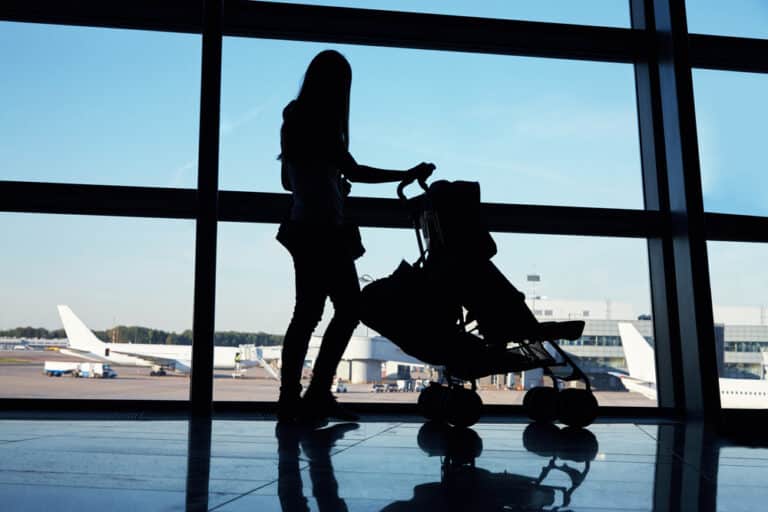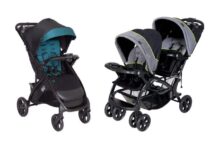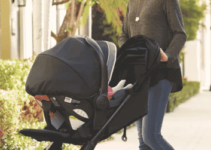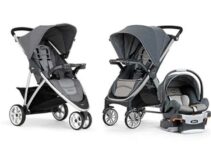Traveling with kids is tricky enough. Toss in the uncertainty of flying with a stroller, and things become all the more complicated. Trust me, I’ve been there – and I wish I had done a little research before traipsing off to the airport. After all, there are many rules and regulations regarding strollers on airplanes.
That’s why I created this handy guide for traveling with a baby stroller. Below, you will find all of the must-know information regarding traveling with a stroller, from whether or not you can take it on the plane to how to protect your stroller while traveling by plane (plus what to do if it gets lost or damaged – it happens!).
Table of Contents
- Can You Take a Stroller on a Plane?
- What Size Stroller Can I Take on a Plane?
- Are Strollers Allowed Through TSA?
- How To Gate Check a Stroller?
- Step 1: Inspect Your Stroller
- Step 2: Take Your Stroller Through Security
- Step 3: Take Your Stroller Up to the Gate
- Step 4: Gate Check Your Stroller
- Step 5: Storing a Stroller in the Aircraft
- Step 7: Connecting Flights
- Step 6: Onboard & Ask for an Open Seat (if possible)
- Step 5: Pick Up Your Stroller
- How big of a stroller can you gate check
- Strollers on Airplanes – Rules and Regulations from Top Airlines
- Can I Bring My Stroller as a Carry-On?
- How to Protect a Stroller When Flying
- What If My Stroller is Lost or Damaged?
- Tips for Flying with Strollers
- The Best Strollers for Flying
- Verdict
Can You Take a Stroller on a Plane?
Yes, you can bring a stroller (and car seat) onto a plane. However, every airline has different rules and regulations for what is allowed. Here are the top three ways you can bring a stroller onto an airplane.
With Checked Baggage Allowance
One of the simplest ways to bring your stroller (and car seats) along for the ride is to have them checked with your baggage. Most American airlines will allow a stroller and car seat along with your regular free baggage allowance, free of charge, depending on your child’s age. (That is why it’s always recommended to double-check airline rules before traveling to the airport).
The best part is that you’re checking your stroller or car seat; you can typically do so in multiple ways for your convenience. For instance, you may be able to check it curbside, at the ticket counter (for example, the Southwest Airlines ticket counter), or departure gate.
In the Overhead Cabin With Carry-On Bags
If your stroller is small enough, you may be able to stash it in the overhead cabin free of charge. If there is enough room, you will be able to transport the stroller in addition to your overhead baggage free of charge.
Note: One car seat per child is also allowed (an FAA-approved car seat is required). While FAA-approved car seats are not required for your baby or small child to fly, it is highly recommended.
In the Overhead Cabin Without Carry-On
Not all airlines are created equal. While some will allow you to bring a compact stroller alongside your carry-on, others demand you choose between one or the other. So, in some circumstances, you sacrifice your standard carry-on allowance to take your stroller on board.
What Size Stroller Can I Take on a Plane?
Generally, airplanes require the carry-on stroller to have a diameter of fewer than ten inches and a length of 36 inches or below.
You needn’t worry about the size if you’re not planning to bring your stroller on board as a carry-on. Generally, all sizes are a-okay. The only essential thing to remember is that the stroller must be collapsible. So, whether you have a large-and-in-charge double stroller or a top-of-the-line jogging stroller with all of the features, as long as it can collapse, you can check it and bring it along for the trip.
As always, the best thing to do is double-check with the airline you’re using, as all airlines have their own rules about what’s allowed and, more importantly, what’s not.
Are Strollers Allowed Through TSA?
Strollers are allowed and are required to be checked by TSA (Transportation Security Administration). This includes all types of strollers and accessories, such as car seats, booster seats, diaper bags, backpacks, etc.
Here are the two most important things to remember about your stroller and TSA checks:
- All items must be removed from the stroller pockets and baskets. Place them in the carry-on bag or on the X-ray belt so they may be appropriately screened. (Be ready, so you do not hold up the line).
- If your stroller (and other pieces of equipment) do not fit through the X-ray machine, they will need to undergo a visual and physical inspection performed by the TSA officers.
How To Gate Check a Stroller?
To gate check a stroller means to check the stroller at the gate of the airport before boarding the flight. This process allows parents to use the stroller throughout the airport until they reach the gate, where airline staff or ground crew members will assist in checking the stroller.
Step 1: Inspect Your Stroller
Before embarking on your journey, it’s essential to thoroughly inspect your stroller. Ensure that your stroller is in good condition and can be easily folded to comply with the airline’s guidelines.
You can check one car seat and one stroller or folding wagon per child you’re traveling with, for free. This can be done at the gate or ticket counter. Large or non-collapsible strollers, and non-folding wagons must be checked at the ticket counter. However, they’re also free.
Some airlines may have restrictions on certain stroller models or charge additional fees for oversized strollers.
Additionally, remove any attachments or accessories from your stroller, such as cup holders, toys, or other add-ons, to prevent them from getting damaged or lost during handling by baggage handlers.
Tips: Consider bringing a stroller bag or cover to protect your stroller from dirt, scratches, and damage during transport.
Step 2: Take Your Stroller Through Security
Upon arriving at the airport, take your stroller through security screening. Like any other item, your stroller must pass through the TSA checkpoint. Follow the airport’s rules and regulations, which usually involve putting your stroller through an x-ray machine.
It’s important to remove your child from the stroller and fold it before you go through the screening process and ensure compliance with security protocols.
Tips: Consider buying or renting a stroller at your destination or renting a car seat if neccessary
Step 3: Take Your Stroller Up to the Gate
After successfully passing through security, take your stroller up to the departure gate. At this point, the flight attendant will likely provide you with a gate-check tag to attach to your stroller. This tag allows you to continue using your stroller through the airport until boarding time. Taking your stroller up to the gate ensures that it remains accessible and convenient for you until the last moment before boarding.
Step 4: Gate Check Your Stroller
If your stroller is too large to fit in the overhead luggage bin inside the plane, you will need to gate check it. When it’s time to board your flight, proceed to the boarding gate with your stroller.
Not all strollers can be gate checked. While they don’t have to be small enough to fit in the overhead bin, they must be 100% foldable and relatively compact.
There will be airline staff or ground crew members at the gate ready to assist you with gate checking your stroller.
They will collect your stroller, attach a gate-check tag to it, and ensure that it is properly secured for transport in the aircraft’s cargo hold.
Tips: While some airlines provide plastic bags for gate-checked items, having your own protective covering can offer added peace of mind.
Step 5: Storing a Stroller in the Aircraft
If your stroller is compact and the aircraft is not full, you may be allowed to bring it onboard with you. In this case, the gate checked stroller goes in the cargo compartment or overhead bin, where other passengers’ luggage is kept.
What happens when you gate check a stroller with a layover?
When you gate-check a stroller with a layover, the process remains largely the same as for a direct flight. You’ll gate-check the stroller before boarding your initial flight, and it will be stored in the aircraft’s cargo hold. During your layover, you won’t have access to the stroller as it will remain with the airline. However, if your layover is short, you can request to have the stroller returned to you at the gate for the layover duration.
Tips: Travel with a smaller, portable stroller that meets your needs
Step 7: Connecting Flights
When traveling with a stroller and taking connecting flights, make sure to write the correct number of the next or connecting flight on the tag provided during the gate check procedure.
This allows for easy access to your stroller during the flight and reduces the chances of it getting misplaced during transfers or connecting flights.
If your stopover is short, you can collect your stroller and check it in again at the next gate.
Tips: Keep your bag tag receipt. You should also take a snap of your bag tag receipt so that you can remember.
Step 6: Onboard & Ask for an Open Seat (if possible)
Arriving early at the airport gives you the opportunity to inquire about an open seat for your child if the flight isn’t fully booked. Gate agents may accommodate your request, providing a comfortable seat for your child to rest during the flight duration. This proactive approach can enhance the travel experience for both you and your child, ensuring a smoother journey.
Step 5: Pick Up Your Stroller
Upon reaching your destination, stand by on the jetway along with other passengers to reclaim your gate-checked stroller. Once the aircraft has landed and passengers are disembarking, airline staff will bring your stroller to the jet bridge for collection.
There is no need to wait at the baggage claim area or sift through luggage. Gate checking your stroller ensures that you can quickly and easily retrieve it upon arrival, minimizing the hassle of waiting and reducing the risk of damage or loss.
How big of a stroller can you gate check
Strollers that are larger then 20 pounds may not be suitable for gate checking in American airlines and may need to be checked in at the ticket counter instead.
Generally, most airlines allow gate checking for strollers that are foldable and relatively compact. While there may not be strict size limitations, it’s essential to ensure that the stroller can fit through the aircraft’s door and be stored safely in the cargo hold.
Strollers on Airplanes – Rules and Regulations from Top Airlines
Many airlines are available to excited travelers, and all of them have their own set of rules for strollers. Below, you will find a quick breakdown of the regulations from well-known airlines you may fly with.
Quick note: we can’t take responsibility for keeping this information up to date so always double-check with the airline’s website or give them a call to confirm:
Air France
Air France allows one child restraint system and a collapsible stroller to be placed in the overhead compartment for international flights for free, except those from France and Pointe-a-Pitre, Fort-de-France, Havana, Saint Martin, Cayenne, Reunion, Mauritius, Punta Canada, and Santa Domingo. However, the stroller must be smaller than 5.9 x 11.8 x 39.4 inches.
Slightly larger strollers (no larger than 21 x 13 x 9 inches) can be placed in the overhead compartment, but they will replace the baggage allowance for your infant. It must be enclosed in a carrying bag or case.
Alaska Airlines
Alaska Airlines has a few different rules for bringing strollers on airplanes.
For one, every stroller or car seat, along with your checked baggage, is allowed free of charge. You can check your strollers and car seats at the ticket counter or bring them to the boarding gate. Gate-checked strollers will then be moved to the hold with your baggage.
If there is room on the airplane, you can bring your stroller on board.
British Airways
British Airways allows smaller, fully collapsible pushchair/lightweight stroller to be left and collected at the aircraft door. They must not exceed 46 x 15 x 15 inches when collapsed. Slightly larger strollers that do not exceed the maximum bag dimensions for carry-on allowance can be brought onto the plane. However, this will replace your carry-on baggage allowance.
Larger strollers for infants traveling internationally or within the country must be checked with standard baggage and picked up at the baggage carousel.
Delta
Delta allows parents to gate-check their strollers and crs’s (or car seats). You can check your baby equipment free of charge at the curb, ticket counter, or gate. They also allow seat restraints to be brought on board, such as a booster seat, bassinet, or in ant seats. However, they must not exceed carry-on size restrictions.
Jet Blue
Jet Blue allows individuals to bring their child’s car seat, foldable stroller, and other equipment, such as a diaper bag, on board the flight. Yet, they do not give infants and small babies hand baggage allowance. So, everything your child requires will need to be packed in your luggage.
Southwest
Southwest Airlines will gate-check your child’s car seat and stroller free of charge, and they can be checked at the curb, ticket counter, or gate. This applies to all types of strollers, from umbrella strollers to larger double strollers and everything in between.
Southwest also offers travelers with reusable car seats and strollers for a low price.
Spirit Airlines
Spirit Airlines accepts an infant car seat and stroller free of charge. They can be left at the gate check and be ready when you arrive at your arrival city, taking the complications out of things.
Spirit Airlines also allows parents to bring a single FAA-approved car seat on board as long as the parent has purchased an infant ticket for them to have their own seat. Keep in mind that not all seats can accommodate a car seat. For example, the child seat cannot have an inflatable seat belt.
United Airlines
When it comes to United Airlines, parents are allowed to bring a car seat and one fully collapsible pushchair per child that does not exceed 9 x 10 x 17 inches. You may also bring a breast pump, milk, and diaper bag. This does not replace your carry-on allowance.
Larger strollers or car seats will need to be gate-checked. If you’re bringing an extra-large wagon or a stroller that does not collapse, you will need to check your items at the counter – they cannot be checked at gate check.
Can I Bring My Stroller as a Carry-On?
The best way to answer this is maybe. It depends on two things – the airline’s rules and the size of your stroller.
The first thing to check is the regulations of the airline. Most airlines will allow a foldable stroller, umbrella stroller, or other small, compact stroller to be used as a carry-on. But not all airlines are created equal. Some do not allow strollers as carry-ons. Others allow strollers on board, but they will replace your carry-on luggage allowance. Regardless, those that accept strollers in the overhead compartment will do so for free.
If the airline accepts strollers as carry-on, you need to double-check the size limits. All airlines will have limitations. For instance, your travel stroller must break down to no more than 46 x 15 x 15 inches to be allowed as a carry-on for British Airways or 5.9 x 11.8 x 39.4 inches for Air France.
If your airline does accept strollers in the overhead bin and your stroller does not exceed the maximum dimensions for carry-ons, then yes, you can bring your stroller on board the flight.
The best thing to do is call the airline or check their website to get an official answer on whether or not you can bring your stroller as a carry-on. (At this point, you should also check for information regarding infant seats, if necessary.)
How to Protect a Stroller When Flying
Traveling with a stroller on an airplane can be nerve-wracking. After all, strollers (and car seats) aren’t cheap, and let’s be honest – the folks handling baggage and working the baggage claim don’t always proceed with utmost caution.
That’s why it is essential for you to take the proper steps to keep your stroller safe and secure while traveling by plane. Here are some of the top tips to consider:
1. Bring it On Board
The absolute best way to ensure your stroller remains in tip-top condition is to bring it on board. That way, you’re in charge of handling it from start to end, and you can make sure nothing bad happens to your precious baby item.
2. Get a Stroller Travel Bag
Not all strollers will be able to make it on board, unfortunately. (We’re looking at you, big and clunky double stroller!) But if you have to check your stroller with your checked baggage, don’t panic – there are still many ways to keep your item safe.
A travel stroller bag will be your best line of defense when it comes to flying with a stroller. A travel stroller bag will keep your stroller safe from the elements, especially dirt, grime, and moisture.
Ensure that your stroller fits inside the bag. You don’t want any of the pieces hanging outside of the bag. Otherwise, it will be susceptible to build-up and potential damage.
Also, make sure the bag is 100% waterproof and durable. The more reliable the stroller travel bag, the less you’ll have to worry about. Consider a padded bag for even more stability and protection.
Lastly, opt for a brightly-colored bag. We all know how hectic baggage claim is. Opting for a bag that’s vivid and easily seen will cut down on potential hours spent searching for your items.
3. Wrap it in Bubble Wrap
I know what you’re thinking – “This is a little over the top.” And, to be honest, you’re probably right. But when it comes to traveling with an essential item like a stroller, I think it’s better to be safe than sorry.
That brings up to my tip number three – wrapping your stroller in bubble wrap (before placing it inside your handy dandy stroller travel bag, of course).
All you need to do is wrap the stroller in bubble wrap and use some tape to keep it securely wrapped around your product. Then, slip it into your stroller travel bag and be on your way.
The extra layer of bubbly protection will keep your stroller from getting damaged. Not only that, but your kids will have a grand time playing with it when you’re done. It’s a win-win for everyone, parents and kids!
4. Pack Stroller Accessories Separately
As a mother of two small kids, I’ve dealt with my fair share of strollers – some amazing, some just OK, and others I had to return the next day. But regardless of how wonderful some of them were, I have to admit one thing – those stroller accessories are pretty flimsy, and that’s true for more expensive and higher-end models, too.
That said, I highly recommend packing stroller accessories separately, lest they get damaged during transportation. I’m talking about all those great extras – cup holders, sun canopies, etc. Remove them and pack them safely in another bag. Yes, this means more time and energy on your behalf, but trust me – you’ll thank me later.
What If My Stroller is Lost or Damaged?
Even with the best preparations and packaging, strollers can still be damaged – or worse, lost altogether. But what happens if your stroller arrives at your final destination with broken pieces? What if it doesn’t arrive at all? Here’s what to do.
If Lost
Once you arrive at your destination, it is crucial to ask an employee at the jet bridge if they have your stroller gate-checked. You do not want to leave this area until they’re confident they do not have your items. From there, you can move to the baggage claim area. If you can’t find your stroller in the baggage carousel, speak to an employee to help them track down your item.
If all steps have been taken, and you’re still without a stroller, you may need to purchase a new stroller nearby. Save the receipt! Most of the time, the airline will reimburse most (if not all) of the cost of replacing your stroller. If the airline does not, you may be able to get reimbursed by your credit card company.
If Damaged
If your stroller is damaged during the flight, things are a bit trickier to remedy. That’s because, while the United States laws state that flights must compensate for damage, it’s not entirely clear what type of “damage” is eligible. For instance, they will not pay for wear and tear, but what constitutes wear and tear?
The best thing to do is to take a photo of your stroller prior to flying. Once you land, check your stroller for any signs of damage. If there is noticeable damage, snap a photo and submit a claim immediately. There will likely be lots of back and forth with the airline before a clear-cut answer as to how they will remedy the situation. And unfortunately, not all claims result in a happy ending.
Tips for Flying with Strollers
Traveling with children of any age can be hectic, but I want the process to be as smooth as possible for you. That’s why I’ve added these handy tips for flying with a stroller. Let’s check it out, parents and guardians!
1. Check Rules Before Packing and Leaving
My number one tip is to check the rules and regulations regarding strollers for your particular airline. Not all airlines have the same rules. Know what to expect before packing and leaving for your flight.
2. Prepare Your Stroller
You want to ensure your stroller is prepared for flight – just like your adorable tot is prepared! To do so, snap a photo of how it looks (you know, in case any damages occur). Remove all the accessories and pack them securely in your luggage. Then, wrap the stroller in bubble wrap and place it in a stroller travel bag.
3. Check Your Stroller – Or Don’t
Now that you’ve prepared your stroller and arrived at the airport, you’ll want to check your stroller. You can check it with the rest of your luggage. Some airlines allow you to check right at the curb or ticket counter.
However, you can also decide to check your stroller at the gate. With a gate check, you won’t have to deal with finding your item at the baggage claim. Your stroller will be brought directly to you once you’ve landed.
Your other option is to bring your stroller on board. This is the ideal choice, but you’ll need to have a very lightweight, compact, and fully collapsable model to do so.
The Best Strollers for Flying
Not all strollers are ideal for traveling, especially when it comes to traveling by plane. That’s why I recently wrote a handy article about my favorite strollers for traveling by airplane. However, if you want a quick breakdown of which strollers to consider for airplane travel, here’s an overview:
The Mountain Buggy Nano V3 is a super small stroller that’s budget-friendly and can easily fit in overhead compartments. It’s easy to transport around the airport thanks to the included carrying strap, and it can even be used with a car seat as an ultra-compact travel system.
If you don’t mind spending more for a top-notch airplane stroller, the gb Pockit+ is an excellent option. It weighs just 10 ½ pounds and has a handy self-standing mode when broken down. The best part is that, while it’s technically an umbrella stroller, it comes with all-terrain wheels for an incredibly smooth ride.
For those that want an actual all-terrain stroller to take along for the ride, the Baby Jogger City Mini GT2 is a must. It glides beautifully and has four different modes to transport children of all ages.
Are you working on a budget? Then consider the Summer Infant 3D. This little stroller fits in overhead bins with ease. And, while it’s low-budget, it’s still a top-tier, lightweight stroller that is best suited for older babies and toddlers.
Lastly, if you’re in a situation like mine and have two adorable kids to tote around, the Joovy Kooper RS2 is the best choice. While it doesn’t fit in overhead compartments, it has a convenient one-hand fold and is incredibly easy to maneuver. You won’t find that with other double strollers!
Verdict
There you have it, parents and guardians! See? Traveling by plane with a stroller isn’t so complicated, and you can bring a stroller and car seat free (one per child). Whether or not it can be carried onto the plane solely depends on the airline’s rules and the size of your stroller, but if it can’t be carried on, you can always gate-check it. Just make sure that if you need to check your stroller, you take photos of it and wrap it carefully with bubble wrap before securing it in a travel stroller bag.
Where are you planning to fly off to with you, your child, and their stroller?










when you plan to fly with a stroller, always remember to carry one baby blanket or cable knit baby stroller blanket.
check online store at eottoncanada.com
best quality of organic cotton baby products.